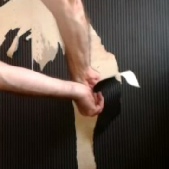




















It is very important when wet stripping wallpaper that you take extra care when working near any electrical switch or power points, as there is some likelihood that excess water will be either splashed or will run down the walls and onto the face of the electrical sockets, and also onto the floor. Therefore I highly recommend Shielding Electrical Power Points and Light Switches when you are wet stripping wallpaper; it is also a good idea to isolate them at the consumer unit as described on my page: Isolating Electric Power Points and Light Switches.
Stripping Wallpaper from below Power Points and Light Switches Face Plates. First Isolate Power Points and Light Switches, and then loosen the cover plate fixing screws of the power point you are working on, allow just enough space to remove the wallpaper; it should then be possible to carefully remove the wallpaper from below the socket faceplate with just the edge of a scrapper. Do not place the scraping tool behind the faceplate more than a 10 millimetres, do not damage or stretch the wires; work slowly and carefully with dry hands and tools. You should then tighten up the cover plate screws and turn the fuses back on at the fuse box and remove any warning label you may have used.
Remember ELECTRICITY CAN KILL so do not take any unnecessary risks, if you are uncertain about what you are doing, then do not proceed and seek help from an electrically competent and knowledgeable person.

